If you purchase an independently reviewed item through our site, we earn an affiliate commission. Read our affiliate disclosure.
Mason bees are solitary bees but can live near each other in nests. For great results when keeping mason bees, be sure to use the best mason bee nesting materials that you have access to. Using quality nesting materials ensure that your starter population of mason bees flourishes and grows in number.
Both beginner and experienced beekeepers can keep mason bees with ease. The bees work with most materials you will think of as long as they are natural and organic plant material. Even then, research indicates that some nesting materials are more friendly and favourable to mason bees. They take to these materials quickly and build compartments more willingly. Pipes and tubes are the preference of mason bees. They love those that have a diameter of around 8 millimeters.
Qualities of the Best Mason Bee Nesting Materials
Mason bee nesting materials can be reusable or not. Reusable materials are best for mason beekeeping. They save you the cost of buying or sourcing for new materials every year for your continued mason beekeeping.
The best nesting materials for mason bees have some or all of these qualities:
1. Derived from plant material
Mason bees show preference to materials that are wooden or derived from plants. They rarely build their nests in materials of any other type. It is only in extreme cases that mason bees will establish a nest on metallic, plastic or other types of materials. Wooden trays are popular nesting materials for mason bees because they are friendly to mason bees, and are reusable.
2. Tubular and narrow
Even when the material is derived from plants, it has to be tubular and often narrow. This is because mason bees make compartments in the nest area. In each compartment, they place an egg and food for the larva that hatches from the egg. They then seal the compartment. Building the entire nest using mud is possible for mason bees, but, they increase in number at a faster rate when you provide tubular and narrow nesting materials. They make and seal up individual compartments faster, allowing them more time to get food material for the individual compartments.
3. Mud can adhere to them
Since mason bees use mud in all their construction, you should use a material to which mud can adhere. The bees wet some soil with their mouth parts and then carry it to the nest. There, they add it to the nest section they are working on and shape it to the correct shape. Mud makes the separating and side walls of each compartment in a mason bee nest.
Overview of the Best Mason Bee Nesting Materials
8. Pollinator Pack for Wild Bees
Pollinator Pack for Wild Bees – 50ct is a pack of nesting tubes for mason bees with tubes of varied diameters. Diameters of nesting materials you will find in the pack are 6 reeds of 8 millimeter diameter, 12 reeds of 6 millimeter diameter, 10 tubes of 8 millimeter diameter, 12 tubes of 6 millimeter diameter and 10 tubes of 4 millimeter diameter. There are 50 tubes in this pollinator tubes pack.
This pack is great in providing a nest for different types of solitary bees. Bees that will make a nest in the tubes depend on the season of the year you set up your solitary bees’ house. Mason bees are sure to use some of the tubes to make their nest. Nesting tubes in this pack are made from natural reeds, and using cardboard. Mason bees work well with both materials.
Check Price
7. Bee Observer – Solitary Bee Observation Tray
The Bee Observer – Solitary Bee Observation Tray is a fun and convenient way to observe the life of solitary bees. It provides you with safety and makes it easy for you to take a peek into the life of solitary bees such as mason bees. This observation tray makes use of a clear window on one side of a tray with mason bee nesting tubes. It works well with mason bee houses, chalets and the Crown Bees’ mason bee cottages.
Use this Bee Observer – Solitary Bee Observation Tray to educate yourself and others about the life of mason bees. It is made to provide mason bees with the natural dark environment they love and also slides out of the bee house for studying mason bee activities. With this observation tray, you easily see the process of mason bee lifecycle from laying eggs to young adults emerging from cocoons.
Check Price
6. Spring Natural Reeds for Mason Bees – 8mm
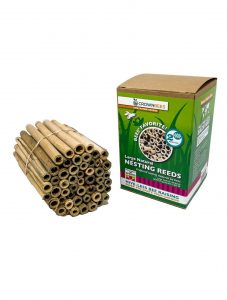
Natural reeds are favorite nesting materials for mason bees. The Spring Natural Reeds for Mason Bees are therefore great for your mason bees. Use them in your mason bee house to provide nesting material. They come in a pack of 250 reed tubes. With 250 tubes, you do not need to purchase additional tubes any time soon. Even when you have a large mason beekeeping operation, these 250 tubes meet all your nesting material requirements with ease.
These natural reeds are attractive to mason bees and to people too. They fit well into your mason bee habitat such as house or chalet. The reeds are in different lengths, so they form an irregular pattern at the front when in use. It allows for mason bees to easily find their individual tubes after flying back to the nest. Gathering the reeds and cutting them to size is by hand.
Check Price
5. Spring Inserts for Mason Bees – 8mm
These are inserts for using inside mason bee nesting tubes. Crown Bees makes them using sooth paper. The Spring Inserts for Mason Bees are easy to use. You insert them into mason nesting tubes and then remove them when you want to harvest cocoons. This allows you to reuse mason bee nesting tubes with ease. Use the inserts with reeds, since reeds are the most difficult mason bee nesting material to reuse.
The Spring Inserts for Mason Bees work well with any nesting material you have. These include drilled holes, nesting tubes and natural reeds. Do not use the spring easy-tear insert refills on their own, without a protective nesting tube. Parasitic wasps drill through the inserts easily. These easy-tear insert refills come in a pack of 250 pieces. It is a large number so they are enough to meet your needs.
Check Price
4. Spring Cardboard BeeTubes for Mason Bees – 8mm
The Spring Cardboard BeeTubes for Mason Bees is an innovative nesting tube. Crown Bees makes the tube using cardboard. It is friendly to the environment and contributes to reusing materials. Use this eco-friendly mason bee nesting material for your mason bees. It comes in an 8 millimeter bore and the cardboard is attractive to mason bees. They quickly take to the material and establish a nest using the tubes.
This mason bee nesting material comes in a pack of 250 pieces. These are enough even for beekeepers with large mason beekeeping operations. 250 tubes fill your nesting space and give you good value for your expenditure. They are well priced and of high quality to provide excellent protection for mason bees. Parasitic wasps cannot get through the cardboard tubes. When it is time to harvest cocoons, these cardboard tubes are easy to tear up.
Check Price
3. Spring Cardboard BeeTubes and Inserts for Mason Bees – 8mm
This is a powerful combination of mason bee nesting materials. It is well priced so you save money by purchasing the combination of nesting tubes and inserts. The nesting tubes in this package are made using cardboard. It is a material that attracts mason bees and they take to it with ease. The inserts for the nesting tubes are also of high quality and effective at their job. Making them utilizes glassine material. The inserts make it possible to reuse the cardboard nesting tubes at the end of your production cycle.
A standard 8 millimeter bore is used in both the nesting tubes and inserts in this package. It is a diameter that mason bees love and which ensures they make many cocoon compartments. Nesting tubes in this package work well with most mason bee houses, chalets and wood trays used in mason bee habitats.
Check Price
2. Spring Reusable Wood Trays for Mason Bees – 8mm
These are reusable and long-lasting wood trays. The Spring Reusable Wood Trays for Mason Bees are in a great design and fit well into mason bee houses and chalets. They are made using wood which mason bees easily take to. Spring reusable wood trays are great for holding nesting tubes and inserts. You can also spray mason bee attractant to them. This makes them important equipment in mason beekeeping.
Crown Bees’ Spring Reusable Wood Trays for Mason Bees come from Northwest Alder wood. They are precision-crafted, safe and provide a natural nesting material for mason bees. Each wood tray has 48 holes for tubes or nesting reeds. Make sure to use your wood tray in a mason bee house. It protects the tray from rain and other destructive elements. These wood trays are easy to take apart when you want to harvest mason bee cocoons.
Check Price
1. Farm Grade Spring Reusable Wood Trays for Mason Bees – 48-Hole

The Farm Grade Spring Reusable Wood Trays for Mason Bees are an economical option for mason bee nesting. They work well with nesting tubes and nesting inserts. Farm grade wood trays come apart easily when it is time for you to harvest mason bee cocoons. Crown Bees makes the wood trays using high quality wood that even has its natural knots and blemishes. Mason bees love it and take to it easily. The wood retains nesting scent so mason bees will establish a nest in the tray very quickly.
This reusable wood tray option is good for many mason beekeepers. It provides both moisture control and insulation for your mason bees. The wood trays are also great at providing mason bee cocoons with protection from predators. Farm grade spring wood trays are precision-crafted with side notches on each piece for easy locking into each other.
Check Price
Leafcutter and Wild Bees Nesting Materials
5. Wild Bee Cardboard BeeTubes – 4mm
The Wild Bee Cardboard BeeTubes the smallest size nesting tubes offered by Crown Bees. They are great for solitary bees and wasps of the smaller sizes. These tubes are easy to work with. Their production utilizes cardboard. It makes the tubes friendly to the environment by reusing a resource that would otherwise be treated as waste. Mason bees work with cardboard tubes very well and have no problem making their nest in these tubes.
Each Wild Bee Cardboard BeeTubes comes with one open end and one closed end. Place the tube in your mason bee habitat with the open end facing outwards. These tubes come in a package containing 250 tubes. They are enough for any insect bee habitat you have.
Check Price
4. Summer Cardboard BeeTubes for Leafcutter Bees – 6mm
The Summer Cardboard BeeTubes for Leafcutter Bees are designed for solitary bees and beneficial wasps. They are used with insect hotels to provide nesting material for pollinator bees. Crown Bees makes the bee tubes using cardboard. Solitary bees work well with cardboard material so they have no problem making their nest in these tubes. The tubes fit into mason bee houses well.
Each pack of Summer Cardboard BeeTubes for Leafcutter Bees comes with 250 tubes. It is a good number for both small and large solitary beekeeping operations. In small operations, 250 tubes last you through several years. For large operations, 250 tubes help you make up several nests without needing to buy many packs of nesting tubes.
Check Price
3. Summer Reusable Wood Trays for Leafcutter Bees
This is a wood tray for use with leafcutter bees. Some other solitary bees may also make their nests in the Summer Reusable Wood Trays. The wood trays are reusable for many years. They are made using high quality wood which makes them very long-lasting. The Reusable wood trays for leafcutter bees allow for easy harvesting of cocoons. They come apart easily, so accessing the cocoons and cleaning the parts of the tray is easy.
The Summer Reusable Wood Trays for Leafcutter Bees is made using Northwest alder wood. It is a wood type that is quickly accepted by leafcutter bees. Once you have had a nest in the wood trays, they retain the nesting scent for long. The scent attracts more leafcutter bees to make their nests in the wood trays. This saves you from having to buy and use attractants.
Check Price
2. Summer Farm Grade Reusable Wood Trays for Leafcutter Bees – 78-Hole
The Farm Grade Summer Reusable Wood Trays for Leafcutter Bees are natural nesting material for leafcutter bees. They are made using natural wood and retain their blemishes and knots. Leafcutter bees quickly make a nest in these wood trays. The wood trays are cut to precision. Pieces of the tray have notches and grooves in them for a perfect fit. It allows for easy assembly of the wood trays and also eases taking the tray apart to harvest cocoons.
This wood tray gives you 78 tubes in your leafcutter bee house. These are enough for a large nest of leafcutter bees. You get many cocoons from the wood trays since there is a lot of space for the solitary bees to use. Wood trays such as the Farm Grade Summer Reusable Wood Trays provide excellent protection, moisture control and insulation.
Check Price
1. Summer Natural Reeds for Leafcutter Bees – 6mm
The Summer Natural Reeds for Leafcutter Bees are suitable for solitary bees including leafcutter and wild nesting hole bees, and even beneficial solitary wasps. They are cut from natural reeds which solitary bees love. Use them in Spring or Summer depending on the type of solitary bees you want to have. These reeds come in slightly varying lengths, so they form an irregular pattern at the front of your insect hotel. An irregular pattern helps the bees to easily find their respective nest tubes.
These natural reeds come in a 6 millimeter diameter which works well with the solitary bees. Purchase them in bulk quantity and get 250 reeds that will last you through several production cycles. Reeds in the pack are gathered and cut by hand, so you are sure of their quality. They are easy to open up when harvesting cocoons.
Check Price
Setting Up a Mason Bee House
Setting up a mason bee house is easy. Both beginner and experienced beekeepers can do it without any difficulty. When starting or expanding your mason beekeeping operation, take into consideration the following;
1. Purchase and Assembly, or Construction
You can buy a ready-made mason bee house or make one by yourself. Buying a mason bee house is often preferred. It allows you to get a house that is made using the best materials and which is sure to work. The house may come already assembled or in parts which you have to assemble together to make the complete house. You can also make your mason bee house using wood or other suitable materials. Some mason beekeepers use derivatives of wood and plants such as card-board and block-board. Such houses made with derivatives of plants and wood are often short-term solutions. They do not last for a long time or are not very much liked by mason bees.
2. Installation Features
When you have assembled your mason bee house, or constructed one, check for installation features. These include hooks, keyholes, holes or eyelets by which you can hang or fix the mason bee house into place. If such a feature is not present on the mason bee house, install it. Doing this before you go to install the mason bee house makes the work easy for you.
3. Location Selection and Orientation
Choosing a location for your mason bee house might need you to look around so that you get the best location. It should be near the plants you want pollinated by the mason bees. The location should also allow the mason bee house to be hit by the morning sun, so that the bees start being active early in the day. Your location should allow for sheltering of the mason bee house from rain, snow and string gusts of wind. Fence poles and the eaves of houses are great locations for installing mason bee houses.
4. Cocoon Addition and Using Attractants
Propagating a mason bee population requires you to have some cocoons. Mason bees build nests in the place which they find themselves upon emerging from their cocoons. You therefore need to place the cocoons in the mason bee house after installing it. This ensures that the bees that emerge from the cocoons build their nest in the mason bee house. Add nesting tubes on time so that the mason bees do not start building the nest onto the walls of your mason bee house. Timely preparation and placement of other materials such as mason bee mud is also best.
You may use some attractant in the mason bee house. It helps lure stray mason bees and those whose nests may be destroyed or removed to your mason bee house. The attractant works best if you apply it in the months of the year when there are live mason bees flying around in the environment. This is usually in mid-spring.
5. Harvesting Mason Bee Cocoons
Commercial mason beekeepers harvest cocoons from their mason bee houses. This is done by taking apart the nesting materials to reach the cocoon. Some nesting materials are reusable while others cannot be used again.
If your mason bee house is well sheltered from rain, snow and strong winds, you can leave the cocoons in their compartments in the nest until mason bees emerge from the cocoons. The eggs hatch, the larvae develops into a pupa in a cocoon and goes into hibernation. In spring, adult mason bees emerge from cocoons and go about reproducing. They then usually die and leave behind the next generation of mason bees going through the stages of their lifecycle.
Mason bee cocoons that are left in their compartments produce mason bees that are acclimatized to the region. Commercial mason beekeepers use various methods to acclimatize mason bees to an area while still in their cocoons. Cooling the cocoons to various temperatures is the most common. It does not acclimatize the mason bee to other factors of the environment such as humidity.
Conclusion
Mason beekeeping is useful for pollination in gardens and even farms. For best results, use the appropriate nesting materials in your mason bee house. The materials you choose to use determine how well your mason bees perform in pollination. This is because they pollinate plants as they are looking for pollen and other foods for their larvae. If the mason bees take poorly to the materials you use in their nest, they build fewer compartments and thus make fewer trips in your garden. Ensure you have healthy populations of mason bees by using the best mason bee nesting materials in your mason beekeeping operation.
What are your thoughts on this article? Leave a comment below and let us know.
 BeeKeepClub Resources and Guides for Beekeepers
BeeKeepClub Resources and Guides for Beekeepers


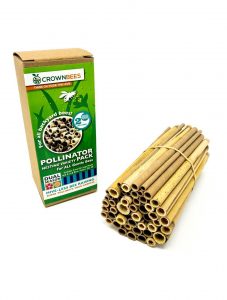
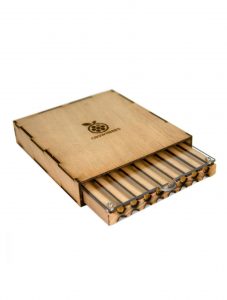

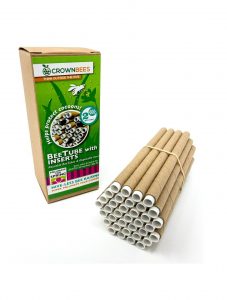
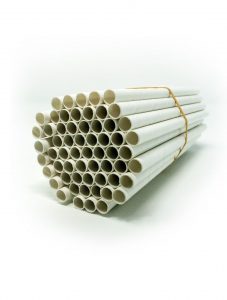
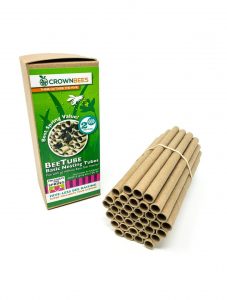

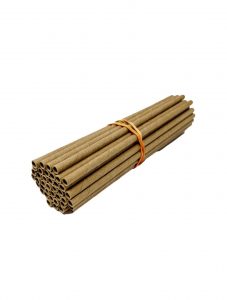
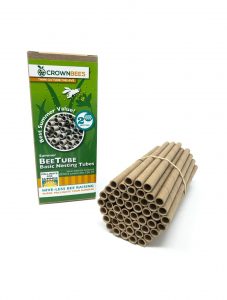

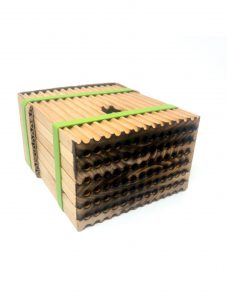
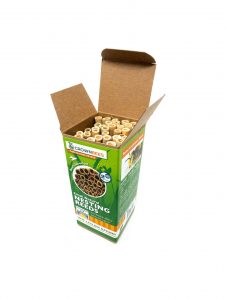

[…] nesting diameter is 6mm and the material should be breathable with a thick wall. One end of the nesting material should be sealed and the other end left open to keep the bees safe from pathogens and parasites […]